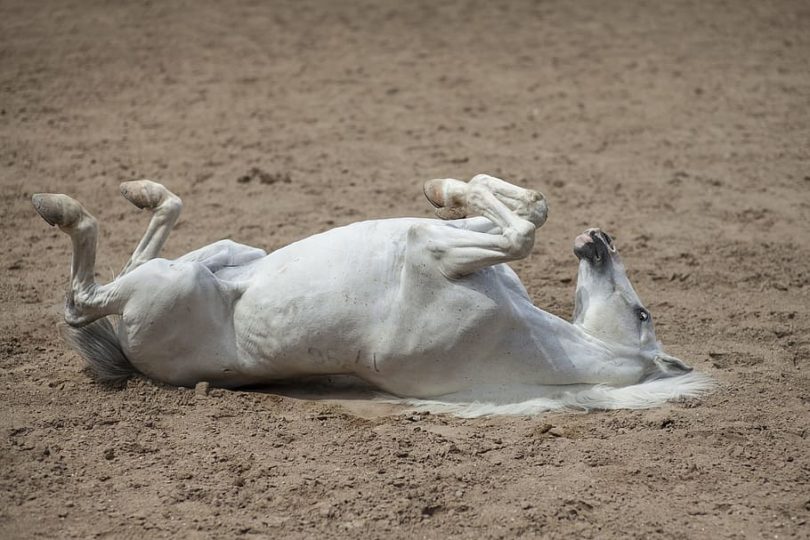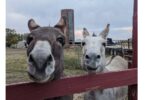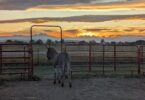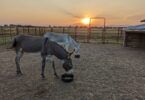Healthy and Happy
Sand Colic is something I hadn’t heard about until I started working at a barn, where all the runs were hard-packed gravel. Gravel is often a practical choice for stable owners. It is great for preventing excessive moisture (keeping your horse from unnecessary hoof issues) and for ease in picking manure.
Though sand is a useful material for many equestrian scenarios, it comes with its own risks. At the top of the list is Sand Colic, a form of digestive illness caused when horses ingest sand that gets stuck in their large colons. Though severe cases may be fatal, there are things you can do to mitigate your horse’s risk like using a hay bag (off the ground) and feeding supplements like Sand Clear.
Sandy Bowels: How It Happens
When your horse eats, he picks up more than just the grass, hay, or grain. If he grazes in a sandy pasture, he will inevitably pick up sand too. Or, he may grab that tender patch of fresh grass and a clump of roots and sand along with it. If your horse lives in a gravel run, he will inevitably ingest some gravel with the fallen bits of hay and grain.
Depending on your horse’s scenario, he may be at a mild-to-moderate risk of sand colic.
When sand or gravel is consumed, it travels through your horse’s digestive system and typically rests in the large colon. Since sand and gravel weigh so much in comparison to the light fiber that his system is meant to handle, it is very difficult to get it to leave the digestive system.
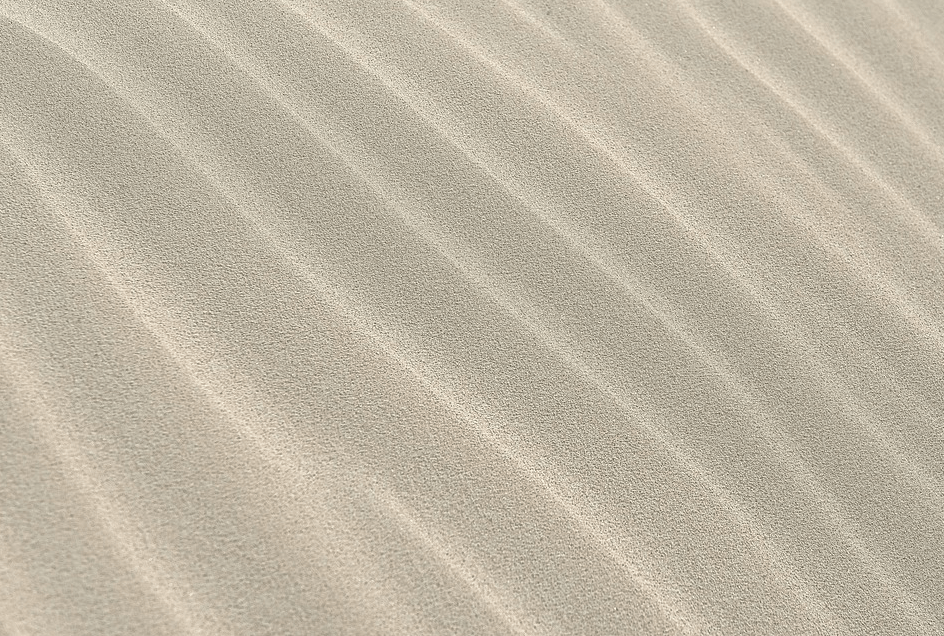
Photo Credit: Pixabay
The large colon is the lowest point of his digestive tract, so gravity does not help the situation at all. The more sand that accumulates, the higher potential for discomfort, illness, and even lethal colic.
From Discomfort to Danger
The sand that resides can cause a range of discomfort. The particles that do make it through the rest of his digestive tract will irritate the horse’s bowels on the way out.
He may also suffer a general stomach pain and diarrhea. Left untreated, this accumulation of sand, gravel, rocks and dirt in your horse’s digestive system will eventually cause a blockage and subsequent colic, which can lead to death.
What Can I Do About It?
Of course, we want our dear equine partners to be in the clear. To begin with, know potential risk factors where your horse is kept. If he lives in a sand or gravel run, make sure his hay is fed to him in a net or bucket (that is routinely dumped out) as opposed to directly on the ground.
If your horse is turned out in a pasture, find out if sand is present in the soil.
There are a few ways to determine whether your horse has sand in his bowels. The at-home test is to take a sample of his manure (fresh as possible) and dissolve it in a plastic bag full of water. The sand will sink to the bottom. There is no direct proportion, however, of sand-in-bag to sand-in-colon.
This is just a basic determinant of whether there is sand in his gut, because each horse will have a different ability to push sand through his system.
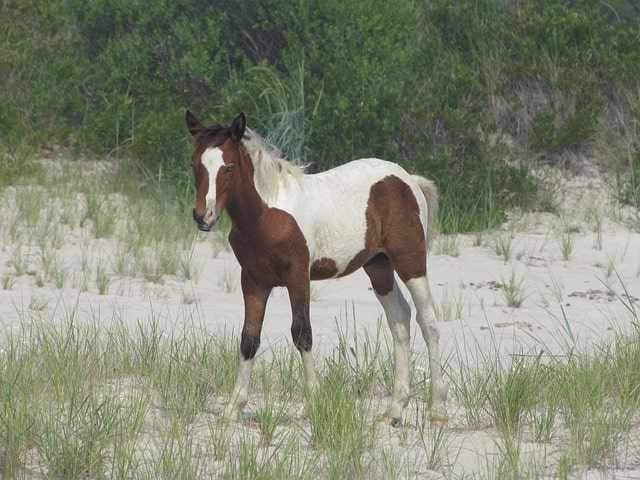
Photo Credit: Pixabay
Your vet will have more advanced ways to determine sand in the colon, including radiograph and ultrasound. If your vet finds that your horse’s case is severe, he can surgically remove the sand. He will likely leave psyllium in your horse’s colon to push the rest out, as he won’t be able to get to all of it surgically.
These measures, it should be noted, are all worst-case scenarios.
There is a much easier way to route sand from your horse’s belly before he even begins to show discomfort from sand and gravel residue.
Enter Sand Clear, a supplement you can add to your horse’s grain that actually tastes of apples and molasses.
The active ingredient is psyllium husk, which is naturally found in psyllium seed. In conjunction with the water in your horse’s intestines, psyllium husk forms a soft, squishy gel that lumps together and pushes all other matter out of the intestines with it. It is gentle and the most thorough ingredient found in removing unwanted matter from the colon.
Wheat bran only has 10% soluble fiber and oat bran less than 15% soluble fiber, whereas psyllium husk has 80% soluble fiber. You will also find this in human form over-the-counter at your local drug store.
Per Sand Clear’s instructions, all it takes is a scoop to a scoop-and-a-half (for the average 1,000 lb. horse) for seven days out of each month. I’m not sure every horse needs this supplement monthly, though. I would recommend every three to six months unless you know your horse favors sand or gravel.
It is not recommended to treat them more often than once a month, as it would risk changing the homeostasis (normal conditions) of your horse’s digestive tract.
As always, consult your vet before making any changes to your horse’s diet and supplements.
Frequently Asked Questions
What are the different types of colic in horses?
Colic is an ambiguous term for abdominal pain and is related to the anatomy and microflora of the equine gastrointestinal tract. There are three main types of colic; gas colic, obstructive lesions, and functional obstructions.
- Gas colic is the most common and easiest to treat.
- Obstructive lesions mean something is blocking passage through the intestines. Impaction colic falls under this category. A twisted intestine is also a blockage, but which is much more serious and complicated to treat. In both cases, the faster they are treated the better the prognosis.
- Functional obstruction means the digestive system isn’t processing food, causing it to just sit in the intestines. Enteritis falls under this category.
What are the common treatments for horse colic?
If a horse is exhibiting signs of colic, hand-walk them so they cannot roll, and call for help.
Many cases can be treated on the farm, but time is of the essence. Call your vet right away to ensure proper treatment. Pain medication, such as Banamine, can be administered, and a stomach tube can be used to alleviate gas colic or administer medications in more severe cases.
In the case of a twisted intestine, surgery might be required. The most common cause of colic is a feed change so it is important to slowly switch hay or grain sources to give the horse’s digestive tract time to adjust. A probiotic can be helpful as a preventative measure to minimize the impact to the microflora in the gut.
What horse problems look like colic? (as in, what are the signs of colic)
Common signs of colic include:
- A horse in obvious discomfort. They may look lethargic, or bite/paw at their abdomen
- The abdomen may look bloated or asymmetrical
- Sweating
- Lack of bowel movements (indicative of an obstruction)
- Strange postures, such as appearing to sit down or stretch out
- No interest in food or water
- If a horse looks uncomfortable and tries to lay down and roll, do not let them! Thrashing about may cause an intestine to become twisted, which seriously changes the colic prognosis
What should you NOT do if your horse colics?
Do NOT let the horse roll!
This means that you should not leave them unsupervised in the stall or in turnout. Hand-walk the horse while you call for help. An equine professional can help diagnose and treat colic. Do NOT just walk away if you observe unusual behavior.
If you aren’t sure, say something. Better to speak up—colic gets worse over time. If you can catch and treat it quickly, it often has a good prognosis. Do not try to ride the horse. If they are in distress, they need treatment, not strenuous exercise.
Does beet pulp help with sand colic?
Sand colic is prevalent in areas with sandy soil and is caused by ingestion of sand which accumulates in the intestine. If you live in an area with sandy soil, feed hay out of a feeder or on mats to minimize the chances of your horse eating sand. Psyllium supplements are a natural laxative and can help dislodge sand from the intestine, but surgery may be required for larger quantities.
Beet pulp is very high in fiber and can help move small quantities of sand or debris through the intestines. Beet pulp is not as effective as psyllium supplements. While beet pulp can be a great feed additive for horses, it is recommended to soak it before feeding as it is a very dry ingredient and can absorb large quantities of water. Soaking beet pulp aids in hydration for the horse and reduces the risk of impaction colic.
P.S. Enjoy this article? Trot on over to:
- Horse Hay FAQs: List of Types of Hay, What Hay is Best, etc.
- Rolling With It: Why Does My Horse Roll Around?
- Food or Foe: What Do Horses Eat (And Why)
- Can horses puke? You might be surprised.
- How Horses Sleep: A-Zzz Guide to Equine Rest
- Daily Horse Care Made Simple (Quick-Print Checklist)
- Horse Lifespan 101 (Life Stages, Teeth, Senior Horse Care)
Sources:
https://standleeforage.com/standlee-barn-bulletin/what-do-you-know-about-beet-pulp
https://thehorse.com/18818/pros-and-cons-of-feeding-horses-beet-pulp/

